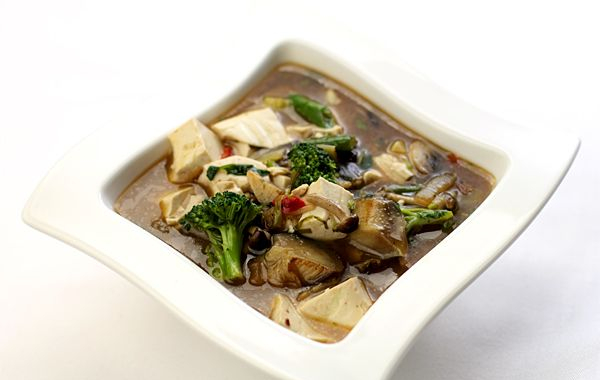By itself, tofu can be very bland; the best remedy is a flavorful sauce paired with a load of vegetables. In this recipe I used leftover chicken, silken tofu, broccoli, red bell peppers, beech and button mushrooms, Japanese eggplant and onions. I added the chicken pieces at the last minute after reserving a portion for the vegetarians in my house.
When paired with a thick, bold, rich peanut miso sauce and served on a bed of steamed jasmine rice, you’ll have a one-dish meal sure to satisfy your family.
1. Info for Tofu with Peanut Miso Sauce
- Cook Time: unavailable
- Total Time: unavailable
- Servings: 6
- Calories: unavailable
2. Ingredients for Tofu with Peanut Miso Sauce
- 1 (18-ounce) package silken soft tofu
- 6 ounces leftover roasted chicken breast (optional)
- 3 tablespoons vegetable oil (or any neutral oil)
- 1 Japanese eggplant
- 1 teaspoon salt
- 1 (1-inch) chunk galangal (or ginger)
- 1 yellow onion, cut into thin wedges
- 3 tablespoons peanut butter
- 2 teaspoons white miso paste
- 2 carrots, peeled and diced
- 1 tablespoon soy sauce
- 1 tablespoon chili bean sauce
- 1½ tablespoons tapioca starch (or corn starch)
- 2 cups homemade vegetable stock (canned vegetable broth or chicken stock)
- 1½ cups broccoli florets, blanched
- 2 cups beech mushrooms, separated
- 6 button mushrooms, sliced lengthwise
3. Directions:
3.1 Prepping the tofu
Drain the liquid from the package of tofu and slice the tofu in four large pieces, horizontally. Silken tofu is quite delicate, so be very careful and gentle. Set aside.
3.2 For the galangal
Clean the galangal and peel it with a paring knife (or the edge of a spoon). Grate the galangal with a fine mesh microplane (about 1 teaspoon) and finely chop the rest. Set aside.
3.3 For the eggplant
Trim the eggplant. Cut it in half lengthwise and slice into 5-6 pieces. Layer a cooling rack on top of a cookie sheet (to collect the excess moisture). Place the eggplant pieces on the rack and sprinkle with salt. Let sit for about 20 minutes, then pat dry using paper towels. Drizzle the eggplant with a little oil and sprinkle with the chopped galangal. Toss well.
In a wok, heat 1 tablespoon oil. Add the grated galangal. Cook until fragrant, then add the eggplant pieces. Ensure that the eggplant pieces are lightly coated in oil (no need to use a lot). Cook for 4-5 minutes until soft and tender. Add the onions and drizzle with soy sauce. Toss well until the onions are shiny. Check doneness of the eggplant (add more water if not fully cooked; I didn’t).
3.4 For the thick peanut miso sauce
Meanwhile, mix the tapioca starch, miso paste, peanut butter, about ½ cup of vegetable stock and chili bean sauce. Whisk well. Set aside.
In the same wok, add the remaining oil. Add the rest of vegetables and stir fry for 3-4 minutes. Transfer to a plate. Add the vegetable stock to the wok. Bring to a boil. Whisk the tapioca mixture one more time to prevent the starch from sticking to the bottom of the wok. Add the tapioca liquid to the boiling broth. Continuously stir the broth as it will thicken very quickly.
3.5 Assembly time
Return all the vegetables to the wok. Add the chicken (if using), Check the texture of the sauce; it should be thickened and syrupy. If you find the sauce to be too thick, add 2 to 4 tablespoons of water. Gently stir in the silken tofu; the spoon will break the silken tofu pieces into large chunks. Cook for about 2 minutes. Adjust seasoning. Season with more salt (if necessary). Cover and let stand until ready to serve.
Serve with steamed rice. I served mine with brown rice for a healthier meal.
Bon appétit!
4. Tips and advices:
- Silken tofu can be found in grocery stores now but I prefer the ones from Korean or Japanese stores. I find its texture to be creamier. Make sure you check for silken soft tofu and not firm on the package.
- One tip to get a perfect sauce is to “over” thicken the broth prior to adding the vegetables. When you add the vegetables, the veggies will release their own liquid and will balance the texture of the sauce.
- Miso paste is a great source of protein for a vegetarian diet. I buy white miso paste (shiro miso) at the Korean store. It’s less salty than regular miso. Don’t be frightened by the size of miso containers sold in markets. Miso paste stores well in the refrigerator and you can make other dishes with it such as Asian salad dressing, other soup broths, sauces and vegetarian gravy.

